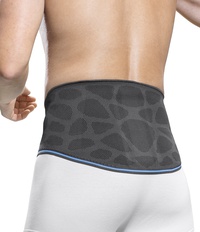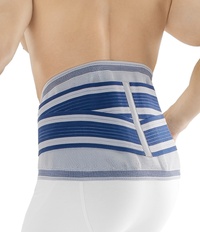Back Pain
Back Pain is among the most frequent ailments in the world
Our spine keeps us upright and stabilizes our upper body. At the same time, the spine must be flexible enough so we can bend, stretch or turn sideways. Numerous ligaments and muscles support these functions and form an important support structure for the spine. Exercising these muscles is important, and our modern semi-sedentary lifestyle means back pain has become a widespread problem all over the world.
Most people occasionally suffer from back pain, while a smaller percentage suffer from chronic pain. In most cases, the pain is caused by permanent bad posture or excessive strain. In addition to postural deformities and muscle inflammation, back pain is often caused by a slipped disc.

Specific and Non-Specific Back Pain
Not all back pain is the same: while around 35 million people visit the doctor every year because of back pain, only 15% of all patients have specific pain. This type of pain is caused by a disease of the spine, where bones and joints can be damaged and restrict movement. A comprehensive CT (computer tomography) or MRI (magnetic resonance imaging) examination can provide clarity. Depending on the findings, the attending physician decides which therapy options are suitable – e.g. physiotherapy and low-impact exercises such as swimming or cycling, or even surgery.
The remaining 85% of patients suffer from non-specific back pain caused by tense, shortened and overstretched muscles or hardened fasciae. In these cases, the medical examination will show that there is no damage to the spine, bones or joints. This non-specific back pain leads to short-term symptoms such as numbness or tingling, but can be treated effectively.
In which area of the back does the pain occur?
Specific as well as non-specific back pain usually occurs in the lower back. The area of the lumbar spine (lumbar spine) and the pelvis is most severely affected. Whether walking, sitting or moving – the central core plays an important role. This often leads to muscle tension, but also to slipped discs.
Over the last ten years in particular, the use of smartphones has further increased the risk of damage to the neck and upper back. The pain is caused by an unfavourable posture. An incorrectly set up workplace also increases the symptoms of the cervical spine. Neck pain often radiates into the back of the head – headaches are a common side effect.
In contrast, pain in the middle back is less frequent. In this area, muscles can be overstrained or hardened, causing pain in the central spine.
Treating Back Pain
With non-specific back pain in particular, maintaining physical activity is recommended. Bed rest and long periods of inactivity can be counterproductive. Active movement and preventive exercises of the abdominal and back muscles can minimize the pain and often even completely prevent it. Stretching exercises are a sensible therapy for shortened muscles. Loosening massages, heat treatments or supporting bandages can also alleviate the symptoms.
Tips for a healthy back
The following simple tips for everyday life can help you improve your back's health and prevent chronic pain.
- Regular exercise: Go outside every day for fresh air. 15 minutes is a good amount of time to start laying the foundation for your wellbeing.
- The classic: Take the stairs instead of using the elevator.
- Carrying and lifting: If possible, distribute your shopping between two bags in order to avoid one-sided strain on the spine. If possible, make sure you kneel and keep your back straight when lifting heavy objects.
- Drink enough fluids: 1.5 litres of fluids (mineral water and/or fruit juice) throughout the day are recommended. Healthy side effect: frequent use of the toilet keeps you moving.
- Use the right chair: A relaxed sitting posture is extremely important in everyday office life. Ensure an ergonomic working posture with a correctly adjusted seat.
- Take a break: If you are predominantly working in a seated position, you should stand up and move around several times during the day. Shake your legs out and swing your shoulders to loosen your muscles.





